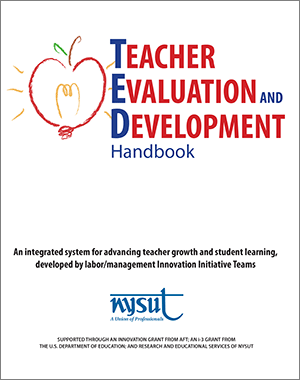Innovation Initiative: Purposeful Use of Peers in Teacher Evaluation
 NYSUT's Innovation teams used the PAR framework outlined in the TED Handbook to guide the design and operational decisions for local PAR programs.
NYSUT's Innovation teams used the PAR framework outlined in the TED Handbook to guide the design and operational decisions for local PAR programs.
North Syracuse: The PAR program is a high functioning, nine-member labor/management committee and is based on a model implemented in Toledo, Ohio, and Montgomery County, Maryland. Consultant teachers (CT) work with a contractual limit of 15 colleagues each. Probationary teachers receive a CT, and veteran teachers with overall composite score ratings of developing or ineffective are assigned a CT. The panel meets monthly to assess and monitor program formation and function, as well as address the needs of CTs, review reports and documents, and deliberate on staff recommendations prior to submission to the superintendent and Board of Education for final decisions. All PAR panel members are trained in the TED evaluation system, which is required under the contract.
Albany: The district currently has a small number of PAR CTs serving in different capacities. One PAR works at the high school level, one at the middle level and others classified as "District PARs" focus on the elementary level. PARs serve as evaluation "coaches," conducting professional development and meeting individually with members
to support implementation and changes to the evaluation system. PARs also "manage" Teacher Improvement Plans at their respective levels. It involves meeting with teachers and conducting paired observations with administrators for TIPs. Finally, PARs each have a caseload of first-year teachers with whom they conduct a formal observation that is rated. PARs also serve on the district's APPR committee and conduct professional development
training for teachers.
Plattsburgh: The PAR program was implemented in 2011. The PAR panel is composed of nine professional staff members of the school district, five members selected by the teachers' association and four administrators selected by the superintendent. Teachers are appointed by the union and serve five-year terms; administrators serve four-year terms. Release time was scheduled as needed to observe and meet with probationary teachers approximately 15 times during the evaluation cycle. The program was expanded to include teachers identified as "ineffective" or "developing." CTs are expected to maintain detailed records about a teacher's performance, their growth over time, and specific recommendations and assistance CTs provide. CTs served on a voluntary basis with no formal compensation until recently when the PAR program became part of the district's budget. The biggest challenge is allocating enough resources to support the professional growth and development needs of both CTs and teachers.